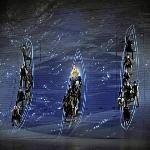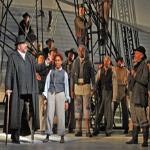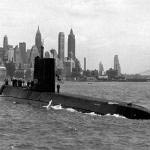
DOUG JOHNSON:
Welcome to American Mosaic in VOA Special English.
(MUSIC)
I'm Doug Johnson.
Today we listen to new music by three country and western performers.
And we answer a question about the first nuclear-powered submarine.
But first, we hear about a new opera based on a famous book.
(MUSIC)
DOUG JOHNSON: "Moby Dick" by Herman Melville is one of the great American novels of the 19th century. It tells about a sailor named Ishmael and his observations on the whaling ship Pequod. The ship's Captain Ahab is seeking to find the great, white whale that destroyed his former ship and bit off his leg. Now, this famous book has been made into an opera. Mario Ritter tells us more.
(MUSIC)
MARIO RITTER: The Dallas Opera in Texas and four other opera companies hired American composer Jake Heggie to write the opera "Moby Dick." He reduced the long story into an opera that lasts about three hours. The bold novel works well as an equally bold opera.
JAKE HEGGIE: "It's a tremendous adventure story. It's got real human drama. It makes sense for people to sing rather than say these words, because the emotions are so huge, the conflicts are so large and so real."
The songs are rooted in 19th and 20th century music. But the video effects used on stage are very much part of the 21st century. Like the book, the opera "Moby Dick" begins quietly. The tense music expresses the restlessness of the sea. Video images of stars shine in a dark, night sky. The stars turn into sea routes, which turn into sailing maps, which then form the shape of a ship.
Special effects artist Elaine McCarthy designed the video. She wanted to represent life on a ship in an unexpected way. The stage itself becomes the ship's surface with sails and rigging.

Ben Heppner sings the role of Captain Ahab. This character has a wooden peg to replace the leg destroyed by Moby Dick. Mr. Heppner had his own leg tied back so that a wooden leg could be attached at the knee. He says it was not easy moving with this device.
Here he sings with the character Starbuck, played by Morgan Smith.
(MUSIC)
Mr. Heggie says that the beauty of the language in the book "Moby Dick" forced him to work in a new way.
JAKE HEGGIE: "The combination of the sweep and scope of Melville's language, the beauty of the story, the depth of the characters all pushed me into a whole new realm of composing and thinking about what music is on the stage."
"Moby Dick" will be performed in Australia next year. Then the opera will move on to Calgary, Canada and the California cities of San Diego and San Francisco.
(MUSIC)
DOUG JOHNSON: Our listener question this week comes from Italy. Robert Corsino wants to know the history of Nautilus, the first nuclear-powered submarine.
There have been many ships named Nautilus, but Nautilus 571 has a special place in history. In 1951, Navy Admiral Hyman Rickover urged the United States Congress to provide money for the first nuclear-powered submarine. Before that time, submarines had operated on diesel fuel and electricity.

The older kind of submarine used in World War Two could stay under water for only about 48 hours. Engineers thought the new nuclear submarine would be able to stay under water for two weeks or more.
After Congress provided the money, the General Dynamics company began building Nautilus in Groton, Connecticut. Work was finished in about two years. Nautilus was put to sea for the first time on January 17th, 1955. The ship's captain sent out a historic message: "Underway on nuclear power."
Nautilus was a large submarine. It was about 98 meters long. It carried 11 officers and a crew of about 100 men. For its first trip, the submarine sailed under water from New London, Connecticut to San Juan, Puerto Rico. It traveled 2,100 kilometers in less than 90 hours. This was the fastest any submarine had ever traveled.
In 1958, Nautilus made another historic trip. The secret project was called "Operation Sunshine." The submarine sailed under and around the North Pole. This was the first time any submarine had made such a dangerous trip.
In 1960, Nautilus was deployed to the Mediterranean Sea to become the first nuclear-powered submarine in the United States Sixth Fleet.
For almost 20 years, Nautilus sailed to many ports around the world. But by 1979, the world's first nuclear-powered submarine had become an old ship. Its last trip that year was from Connecticut to California. It was then "decommissioned" or retired by the navy.
But the life of Nautilus did not end there. The sub was brought back to the East Coast of the United States and became a floating museum in 1986. It is now a major part of the United States Navy Submarine Force Museum and Library near New London, Connecticut. Each year thousands of people visit the museum and go on board the submarine that made history -- the U.S.S. Nautilus.
(MUSIC)
DOUG JOHNSON: Three of the biggest names in country music have each recently released new albums. Barbara Klein tells us about the latest records from Merle Haggard, Willie Nelson and Alan Jackson.
BARBARA KLEIN: Merle Haggard has spent 50 years as a singer, songwriter and guitarist. He became a star of what was known as the Bakersfield Sound. It came out of California where he was born. The sound had a rougher and more rebellious edge than the highly produced country music coming out of Nashville, Tennessee.

Merle Haggard is 73 now. He says his latest album "I Am What I Am" is more personal and a little more from the heart than earlier records. Here is "I've Seen It Go Away."
(MUSIC)
The latest album from Willie Nelson is simply called "Country Music." It includes bluegrass and spirituals. All but one of the songs were written by others. The producer was the highly skilled T Bone Burnett.
Here is Willie Nelson with "Drinking Champagne."
(MUSIC)
Alan Jackson is a generation younger than Willie Nelson and Merle Haggard. His newest record "Freight Train" is his 18th album. We leave you with Alan Jackson and Lee Ann Womack performing a love song. Here is "Till the End."
(MUSIC)
DOUG JOHNSON: I'm Doug Johnson. Our program was written by Jim Tedder, Bill Zeeble and Dana Demange who was also the producer.
You can find transcripts, MP3s and podcasts of our shows at voaspecialenglish.com. If you have a question about American life, send an e-mail to mosaic@voanews.com. Please remember to tell us your name and where you live.
Join us again next week for AMERICAN MOSAIC, VOA's radio magazine in Special English.
Speeches that sent off the graduates of 2010
Women go to new depths in the navy
'A View From the Bridge' is looking better than ever
Americans sing the praises of TV's 'Glee'
(来源:VOA 编辑:陈丹妮)
